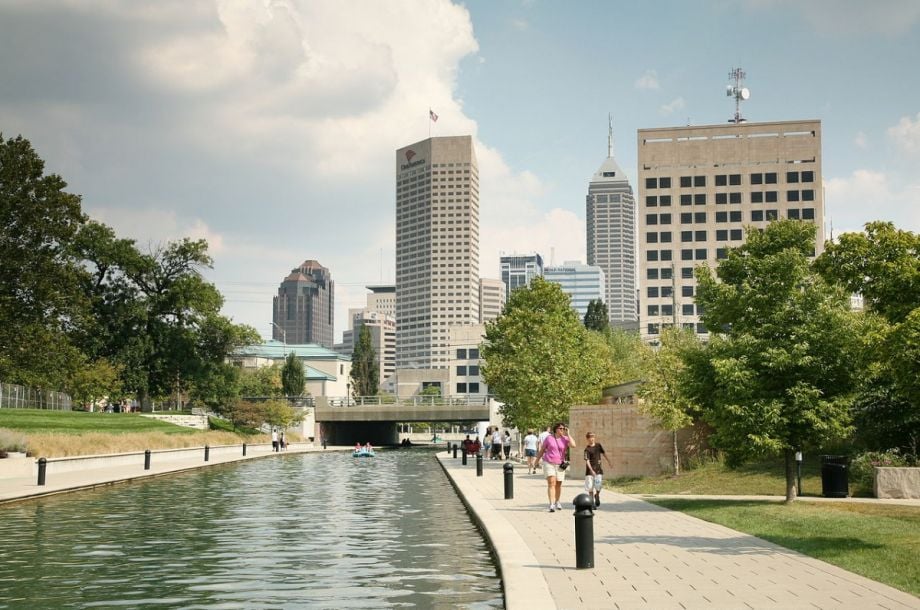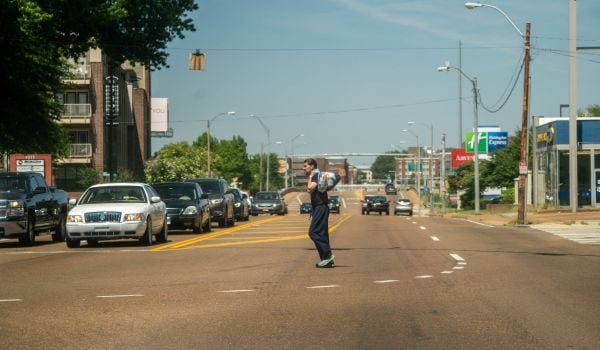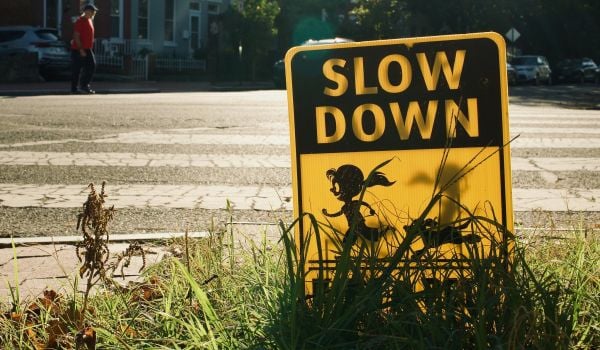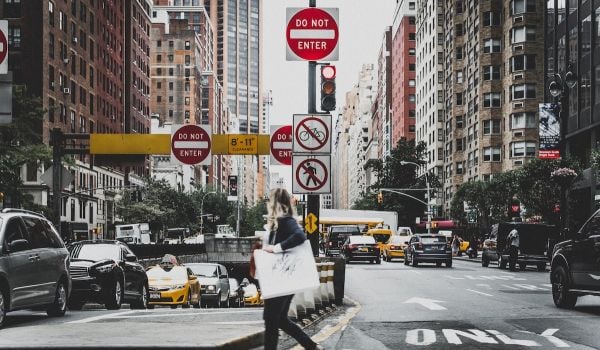Low-slung homes, green lawns and no sidewalks: Many neighborhoods just outside downtown Indianapolis showcase the suburban ideal of the 1950s and 1960s. Developed at the height of the automobile, they made Indiana’s capital city a car-centric town. Paths are sometimes worn through the grass like an urban trail, a stripe of pounded dirt cutting through the green that marks how residents have nonetheless found a way to walk their dogs and visit their neighbors on foot.
Despite the apparent need for sidewalks, Indianapolis went more than 20 years without constructing one. With a consolidated city-county government, the footprint of municipal services encompasses 3,000 miles of thoroughfares and residential streets over 400 square miles. But it’s not just cars and bikes navigating those streets; there are also pedestrians on the asphalt, hugging the side of the road and trying to patch their way through a city that wasn’t designed with them in mind.
But in 2010, Indianapolis saw an infusion of $500 million after it sold its water and sewer utility to a public charitable trust. That money was designated for investment in infrastructure projects in a five-year program called RebuildIndy. Fifty public meetings were held to gather ideas for how to spend the money.
“Consistently, sidewalks were at or near top of list, along with trails and bikeways,” says Scott Manning, communications director at Indy’s Department of Public Works. While a zoning change in the 1990s required that new developments install sidewalks, there hadn’t been enough major projects for that to make a dent. The approximate cost to build all the missing sidewalks along thoroughfares had swelled to $365 million. People were ready for a change.
The city put together a five-year plan for capital improvements, including $29 million dedicated to filling the sidewalk gap: constructing sidewalks where none existed and repairing ones that were in poor shape. There had been such a great need for funding that many projects had already been identified, designed and even partially constructed before being shelved. The city picked up those immediately and completed them in 2010. Since then, city leaders have re-evaluated needs on a yearly basis, tweaking the plan for how to invest the money. They also adopted one of the strongest complete streets ordinances in the nation in 2012. This year, Indy is constructing a number of other new sidewalks along busy streets. It will also spend nearly $15 million to extend the Eagle Creek Greenway, a key connector among west side neighborhoods, and repair the crumbling Keystone Avenue bridge over 86th Street.
At a time of nationwide disinvestment in public infrastructure, the city can boast of moving in the opposite direction. Before 2010, there was less than a mile of bike lanes in Indianapolis. Now, there’s over 90 miles. Seventy miles of trails have been built, along with about 900,000 linear feet of sidewalk, nearly 10,000 ADA-compliant access ramps and two roundabouts. The RebuildIndy effort also repaired 119,511 linear feet of alleyways and 89 bridges, and resurfaced 1,821 lane miles of roads. It also planted 14,441 trees, and made energy-saving retrofits on nearly 700 traffic signals. For the first time in generations, people living in or moving to the urban core can opt out of a car commute.
But following this year’s projects, the fund is exhausted, and Manning knows there is more work to be done.
“Going into RebuildIndy, we knew that $500 million in funding for infrastructure would have a significant impact,” he says. “But when you weigh that against infrastructure needs in the city as a whole, that’s just a small portion of what’s needed.”
But that’s where another lasting impact of RebuildIndy comes in.
“I like to point out that people get tired of asking for something that never comes through,” Manning says. “Lots of people knew their neighborhood needed sidewalks, but when you go 20-plus years without any construction, you get tired of asking. Even though the need’s still there, you just stop talking about it so much.”
Now, that conversation has a defined space in the public sector. “Going forward, the next mayor, and the mayor after that, and the city-county council, whether they want to or not, they will have to acknowledge that sidewalks and connectivity are a big issue,” Manning says.
Indeed, a larger movement to remake Indianapolis into a pedestrian-friendly city is unfolding. A 2014 study showed that Indianapolis was just behind Detroit in U.S. cities that were seeing the biggest increase in car-less households. About 1,600 residents hold yearly passes to the city’s bike-share program,, which has 26 stations, and 28,000 people bought day passes last year, meaning that there were 108,000 bike trips crisscrossing Indy. And ever since 2008, when the city built the eight-mile Cultural Trail, the city’s reaped big benefits: Property values increased by $1 billion, businesses have seen more sales, and residents feel safer.
Also, the city’s first car-share debuted this year, a public-private program called Blue Indy that offers a fleet of electric cars to residents. An initiative by Republican Mayor Greg Ballard, it is focusing on downtown in its first phase, but officials expect to launch up to 500 vehicles at 200 stations. (Until then, it will have to work out some kinks with business owners who worry that the sharing stations are gobbling up too much downtown parking.)
And this spring, Health by Design, a statewide nonprofit, announced that it received a $135,000 Plan4Health grant from the American Planning Association to develop Indianapolis’ first comprehensive pedestrian plan, along with a campaign that promotes walking. The idea is that walkable urban design will puncture two of the leading factors in poor health: a lack of physical activity and a lack of access to good food. In Marion County, where Indianapolis lies, one in three adults are overweight or obese. Heart disease, high blood pressure and asthma are also common afflictions, disproportionately borne by people of color and low-income residents — the people who tend to be, design-wise, disconnected from the wider city.
“This is an opportunity for us to really think about where our needs are, and how we should prioritize funding,” says Kim Irwin, Health by Design’s executive director. The organization will partner with the city and others on the plan.
At stake is not just the city’s economic and health indicators, but also public safety. The city has seen a raft of pedestrian-car collisions over the years. Three of them happened in one day this April. Many of the accidents are fatal. In 2014, a report from Smart Growth America ranked Indianapolis as the 25th-most dangerous city for pedestrians.
“It’s pretty impactful when you look at a map of pedestrian crashes and see them clustered around arterial streets where there are high speeds and no real pedestrian infrastructure,” Irwin says.
Meanwhile, the city is trying to determine how to sustain capital projects with its dedicated funding depleted. Manning says they are working with the city-county council to do $70 million in bonding for infrastructure projects that will allow them to do more sidewalk work. When having to make tough calls on where to invest in a city that still has great need for connectivity, Manning says they focus first on where they can have the most transformative impact on multimodel transit, so that sidewalks sync with trails, which in turn sync with bike lanes and public transit. City officials are also connecting destinations — prioritizing sidewalks that, for example, run along a thoroughfare that reaches a library or retail center. “Those are the projects we attack first,” Manning says, “and as a result of that, we’re able to have a cascading affect.”
Irwin added that the planning process, both for RebuildIndy and the forthcoming pedestrian plan, is about a community discovering what its collective values are. At the same time, it’s an exercise in public education — helping residents see how even if a sidewalk doesn’t get constructed on their own street, there’s still an inherent value for the community overall when they are built on other streets, especially high-traffic ones or ones where there is a large population of aging, disabled or very young residents.
If all goes as Irwin hopes, the collective values of Indianapolis will point toward a 2016 referendum that will see residents vote to raise taxes to fund the initial extension of the region’s multimodal transit system, Indy Connect. But whether it’s sidewalks, trains, buses, bike lanes or trailways, the broader point that Irwin wants to make, especially to decision-makers who hold the purse strings, is that the money spent on pedestrian infrastructure and transit impacts not just the individuals who actively use them, but the overall community.
“It doesn’t matter if you care about health or not,” says Irwin. “There’s something for everyone in this. It’s a worthy investment.”
The Works is made possible with the support of the Surdna Foundation.

Anna Clark is a journalist in Detroit. Her writing has appeared in Elle Magazine, the New York Times, Politico, the Columbia Journalism Review, Next City and other publications. Anna edited A Detroit Anthology, a Michigan Notable Book. She has been a Fulbright fellow in Nairobi, Kenya and a Knight-Wallace journalism fellow at the University of Michigan. She is also the author of THE POISONED CITY: Flint’s Water and the American Urban Tragedy, published by Metropolitan Books in 2018.
Follow Anna .(JavaScript must be enabled to view this email address)

















